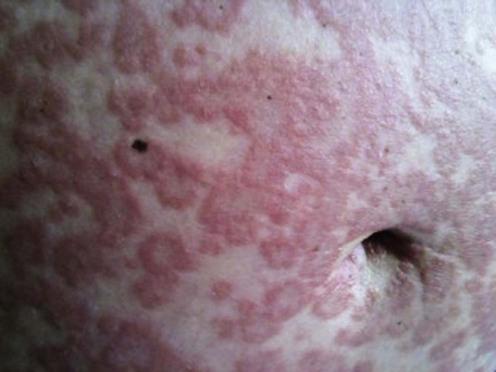Pregnancy dermatoses

Pruritic urticarial papules and plaques of pregnancy
Specific Investigations
First-line therapies
Second-line therapies
Pemphigoid gestationis
Management strategy
 If the mother wishes to breastfeed, the drugs pass into the breast milk. Antihistamines may cause drowsiness in the baby, and corticosteroids may cause adrenal suppression. The pediatrician should therefore be informed in this situation
If the mother wishes to breastfeed, the drugs pass into the breast milk. Antihistamines may cause drowsiness in the baby, and corticosteroids may cause adrenal suppression. The pediatrician should therefore be informed in this situation
 In general, pemphigoid gestationis tends to improve postpartum: however, it may take weeks, months, or even years until there is complete remission. In those cases alternative drugs that are contraindicated during pregnancy or while the mother is breastfeeding may be used. Owing to its close relationship to bullous pemphigoid, in this situation the full range of immunosuppressive treatment may be tried as adjunctive therapy either with oral corticosteroids or alone. Other drugs that may be used are goserelin and ritodrine. High-dose intravenous immune globulin alone or in combination with cyclosporine or cyclophosphamide has been tried with success in rare cases for its corticosteroid-sparing effect
In general, pemphigoid gestationis tends to improve postpartum: however, it may take weeks, months, or even years until there is complete remission. In those cases alternative drugs that are contraindicated during pregnancy or while the mother is breastfeeding may be used. Owing to its close relationship to bullous pemphigoid, in this situation the full range of immunosuppressive treatment may be tried as adjunctive therapy either with oral corticosteroids or alone. Other drugs that may be used are goserelin and ritodrine. High-dose intravenous immune globulin alone or in combination with cyclosporine or cyclophosphamide has been tried with success in rare cases for its corticosteroid-sparing effect
 Pemphigoid gestationis tends to exacerbate with menstruation. There may also be dramatic flares with oral contraceptives. Thus, patients should be recommended to avoid oral contraceptives as long as the disease is still active.
Pemphigoid gestationis tends to exacerbate with menstruation. There may also be dramatic flares with oral contraceptives. Thus, patients should be recommended to avoid oral contraceptives as long as the disease is still active.
First-line therapies
Third-line therapies
Pruritus gravidarum
Specific investigations
Prescribing in pregnancy
 There should be a strict indication that requires a precise knowledge of the diagnosis and the course of the disease
There should be a strict indication that requires a precise knowledge of the diagnosis and the course of the disease
 A drug with as few active components as possible should be selected
A drug with as few active components as possible should be selected
 The pharmacology of the active component and its safety during pregnancy should be established
The pharmacology of the active component and its safety during pregnancy should be established
 A precise knowledge of the duration of the pregnancy (weeks of gestation) is essential
A precise knowledge of the duration of the pregnancy (weeks of gestation) is essential
 A drug that shows the best benefit-to-risk ratio should be selected.
A drug that shows the best benefit-to-risk ratio should be selected.



 Topical corticosteroids
Topical corticosteroids Antihistamines
Antihistamines Systemic corticosteroids
Systemic corticosteroids Early delivery
Early delivery

 Topical corticosteroids
Topical corticosteroids Systemic corticosteroids
Systemic corticosteroids Antihistamines
Antihistamines Plasmapheresis
Plasmapheresis High-dose intravenous immuneglobulin
High-dose intravenous immuneglobulin Azathioprine
Azathioprine Cyclophosphamide
Cyclophosphamide Cyclosporine
Cyclosporine Dapsone
Dapsone Sulfapyridine
Sulfapyridine Pyridoxine
Pyridoxine Ritodrine
Ritodrine Goserelin
Goserelin

 Emollients and topical antipruritic agents
Emollients and topical antipruritic agents Antihistamines
Antihistamines Ursodeoxycholic acid
Ursodeoxycholic acid Cholestyramine
Cholestyramine Phototherapy
Phototherapy




